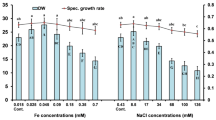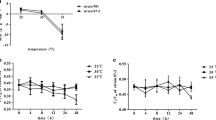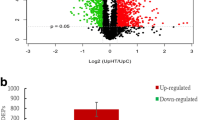Abstract
We used proteomic approaches to study the survival and defense mechanisms of Antarctic microalga under heat stress. The microalga was cultured for optimal growth at 4°C, the temperature was increased to 15°C, and the resultant differentially expressed proteins induced by heat stress were analyzed by mass spectrometry following two-dimensional gel electrophoresis. Orthologues of 22 proteins showed more than two-fold changes in abundance; of these, 8 proteins were up-regulated, and 14 were down-regulated. In addition, changes in the enzyme activities and isozyme profiles of catalase, aldehyde dehydrogenase, superoxide dismutase, glutathione reductase, and ascorbate peroxidase were investigated using an in-gel activitystaining method. Alterations in protein expression and antioxidant enzyme activity in Antarctic algae may be related to survival and defense mechanisms against elevated temperatures.
Similar content being viewed by others
References
Meredith, M.P. & King, J.C. Rapid climate change in the ocean west of the Antarctic Peninsula during the second half of the 20th century. Geophys. Res. Lett. 32, L19604–L19609 (2005).
Watson, R.T. Climate change 2001: Synthesis report, a contribution of working groups I, II, and III to the third assessment report of the intergovernmental panel on climate change, Cambridge University Press (2001).
Peck, L.S., Webb, K.E. & Bailey, D.M. Extreme sensitivity of biological function to temperature in Antarctic marine species. Funct. Ecol. 18, 625–630 (2004).
Park, H. et al. Molecular cloning, characterization, and the response of manganese superoxide dismutase from the Antarctic bivalve Laternula elliptica to PCB exposure. Fish Shellfish Immunol. 27, 522–528 (2009).
Jeon, Y.M., Park, S.K., Kim, W.J., Ham, J.H. & Lee, M.Y. The effects of TiO2 nanoparticles on the protein expression in mouse lung. Mol. Cell. Toxicol. 7, 283–289 (2011).
Deal, R.B. & Henikoff, S. Gene regulation: A chromatin thermostat. Nature 463, 887–888 (2010).
Stolzing, A. & Scutt, A. Effect of reduced culture temperature on antioxidant defences of mesenchymal stem cells. Free Radic. Biol. Med. 41, 326–338 (2006).
Kumar, S.V. & Wigge, P.A. H2A.Z-containing nucleosomes mediate the thermosensory response in Arabidopsis. Cell 140, 136–147 (2010).
Stauber, E.J. et al. Proteomics of Chlamydomonas reinhardtii light-harvesting proteins. Eukaryot. Cell 2, 978–994 (2003).
Wang, S.B., Hu, Q., Sommerfeld, M. & Chen, F. Cell wall proteomics of the green alga Haematococcus pluvialis (chlorophyceae). Proteomics 4, 692–708 (2004).
Shepard, J.L., Olsson, B., Tedengren, M. & Bradley, B.P. Protein expression signatures identified in Mytilus edulis exposed to PCBs, copper and salinity stress. Mar. Environ. Res. 50, 337–340 (2000).
Kim, Y.K., Yoo, W.I., Lee, S.H. & Lee, M.Y. Proteomic analysis of cadmium-induced protein profile alterations from marine alga Nannochloropsis oculata. Ecotoxicology 14, 589–596 (2005).
Kim, M., Ahn, I.Y., Cheon, J. & Park, H. Molecular cloning and thermal stress-induced expression of a piclass glutathione S-transferase (GST) in the Antarctic bivalve Laternula elliptica. Comp. Biochem. Physiol. A Mol. Integr. Physiol. 152, 207–213 (2009).
Park, H., Ahn, I.Y. & Lee, H.E. Expression of heat shock protein 70 in the thermally stressed Antarctic clam Laternula elliptica. Cell Stress Chaperones 12, 275–282 (2007).
Park, S.K., Jin, E.S. & Lee, M.Y. Expression and antioxidant enzymes in Chaetoceros neogracile, an Antarctic alga. CryoLetters 29, 351–361 (2008).
Place, S.P. & Hofmann, G.E. Constitutive expression of a heat shock protein, hsp70, in phylogenetically divergent Antarctic fish. Polar Biol. 28, 261–267 (2005).
Song, L. et al. The cDNA cloning and mRNA expression of heat shock protein 70 gene in the haemocytes of bay scallop (Argopecten irradians, Lamarck 1819) responding to bacteria challenge and naphthalin stress. Fish Shellfish Immunol. 21, 335–345 (2006).
Clark, M.S., Fraser, K.P. & Peck, L.S. Antarctic marine molluscs do have an HSP70 heat shock response. Cell Stress Chaperones 13, 39–49 (2008).
Liu, S. et al. Molecular cloning and expression analysis of a cytosolic Hsp70 gene from Antarctic ice algae Chlamydomonas sp. ICE-L. Extremophiles 14, 329–337 (2010).
Chang, J., Baloh, R.H. & Milbrandt, J. The NIMAfamily kinase Nek3 regulates microtubule acetylation in neurons. J. Cell Sci. 122, 2274–2282 (2009).
White, M.C. & Quarmby, L.M. The NIMA-family kinase, Nek1 affects the stability of centrosomes and ciliogenesis. BMC Cell Biol. 9, 29 (2008).
Kang, D.K. & Lee, M.Y. Photoprotective effects of minerals from Korean indigenous ores on uvA-irradiated human dermal fibroblast. Mol. Cell. Toxicol. 4, 150–156 (2008).
Nassoury, N., Fritz, L. & Morse, D. Circadian changes in ribulose-1,5-bisphosphate carboxylase/oxygenase distribution inside individual chloroplasts can account for the rhythm in dinoflagellate carbon fixation. Plant Cell 13, 923–934 (2001).
Anestis, A., Pörtner, H.O., Lazou, A. & Michaelidis, B. Metabolic and molecular stress responses of sublittoral bearded horse mussel Modiolus barbatus to warming sea water: implications for vertical zonation. J. Exp. Biol. 211, 2889–2898 (2008).
Hofmann, G.E. & Todgham, A.E. Living in the now: physiological mechanisms to tolerate a rapidly changing environment. Annu. Rev. Physiol. 72, 127–145 (2010).
Ramnanan, C.J. & Storey, K.B. Glucose-6-phosphate dehydrogenase regulation during hypometabolism. Biochem. Biophys. Res. Commun. 339, 7–16 (2006).
Gao, M.J., Parkin, I., Lydiate, D. & Hannoufa, A. An auxin-responsive SCARECROW-like transcriptional activator interacts with histone deacetylase. Plant Mol. Biol. 55, 417–431 (2004).
De Alwis, R., Fujita, K., Ashitani, T. & Kuroda, K. Volatile and non-volatile monoterpenes produced by elicitor-stimulated Cupressus lusitanica cultured cells. J. Plant Physiol. 166, 720–728 (2009).
Kuo, C.J. et al. Cloning and characterization of an antifungal class III chitinase from suspension-cultured bamboo (Bambusa oldhamii) cells. J. Agric. Food Chem. 56, 11507–11514 (2008).
Banik, M., Garrett, T.P. & Fincher, G.B. Molecular cloning of cDNAs encoding (1—>4)-beta-xylan endohydrolases from the aleurone layer of germinated barley (Hordeum vulgare). Plant Mol. Biol. 31, 1163–1172 (1996).
Li, L., Ilarslan, H., James, M.G., Myers, A.M. & Wurtele, E.S. Genome wide co-expression among the starch debranching enzyme genes AtISA1, AtISA2, and AtISA3 in Arabidopsis thaliana. J. Exp. Bot. 58, 3323–3342 (2007).
Korkina, L., Scordo, M.G., Deeva, I., Cesareo, E. & De Luca, C. The chemical defensive system in the pathobiology of idiopathic environment-associated diseases. Curr. Drug Metab. 10, 914–931 (2009).
Vitória, A.P., Lea, P.J. & Azevedo, R.A. Antioxidant enzymes responses to cadmium in radish tissues. Phytochemistry 57, 701–710 (2001).
Jeon, Y.M., Park, S.K. & Lee, M.Y. Toxicoproteomic identification of TiO2 nanoparticle-induced protein expression changes in mouse brain. Animal Cells Syst. 15, 107–114 (2011).
Kim, Y.K. & Lee, M.Y. Proteomic analysis of differentially expressed proteins of rice in response to cadmium. J. Korean Soc. Appl. Biol. Chem. 52, 428–436 (2009).
Vega, J.M., Garbayo, I., Dominguez, M.J. & Vigara, J. Effect of abiotic stress on photosynthesis and respiration in Chlamydomonas reinhardtii: Induction of oxidative stress. Enzyme Microb. Technol. 40, 163–167 (2006).
D’Auria, J.C. & Gershenzon, J. The secondary metabolism of Arabidopsis thaliana: growing like a weed. Curr. Opin. Plant Bio. 8, 308–316 (2005).
Seo, J.S. et al. Environmental stressors (salinity, heavy metals, H2O2) modulate expression of glutathione reductase (GR) gene from the intertidal copepod Tigriopus japonicas. Aquat. Toxicol. 80, 281–289 (2006).
Cho, Y.M. Study of low temperature adaptive mechanisms in Antarctic green microalga AnF0048. MS thesis, Hanyang University, Korea (2010).
Jeon, Y.M., Son, B.S. & Lee, M.Y. Proteomic analysis of the differentially expressed proteins by airborne nanoparticles. J. Appl. Toxicol. 31, 463–470 (2011).
Choi, K.M. & Lee, M.Y. Effect of freezing stress on the proteome expression of Antarctic green microalga. Mol. Cell. Toxicol. 8, 163–169 (2012).
Lee, M.Y. & Shin, H.W. Cadmium-induced changes in antioxidant enzymes from the marine alga Nannochloropsis oculata. J. Appl. Phycol. 15, 13–19 (2003).
Park, S.K., Jin, E.S., Lee, C.G. & Lee, M.Y. High light induced changes in the activities of antioxidant enzymes and the accumulation of astaxanthin in the green alga Haematococcus pluvialis. Mol. Cell. Toxicol. 4, 300–306 (2008).
Author information
Authors and Affiliations
Corresponding author
Rights and permissions
About this article
Cite this article
Choi, K.M., Lee, M.Y. Differential protein expression associated with heat stress in Antarctic microalga. BioChip J 6, 271–279 (2012). https://doi.org/10.1007/s13206-012-6310-5
Received:
Accepted:
Published:
Issue Date:
DOI: https://doi.org/10.1007/s13206-012-6310-5




